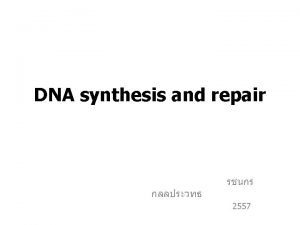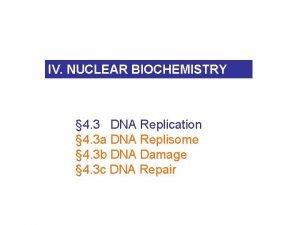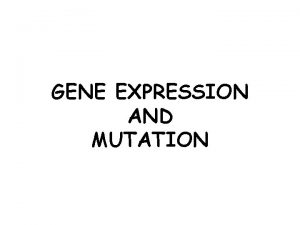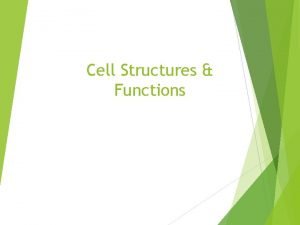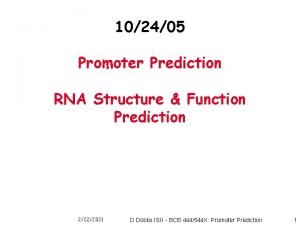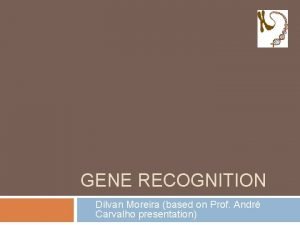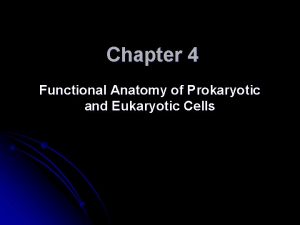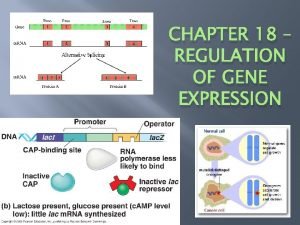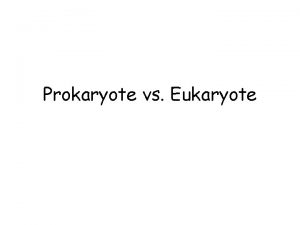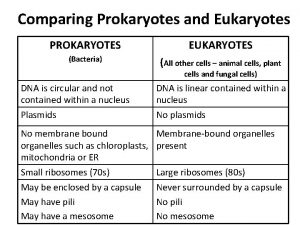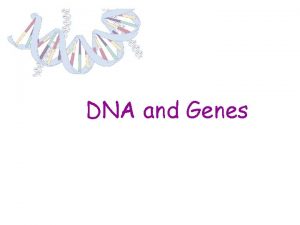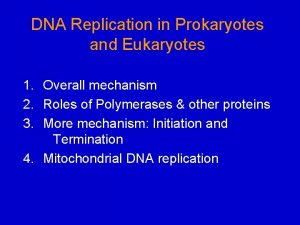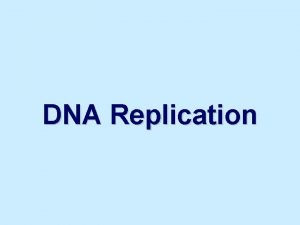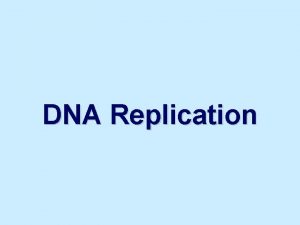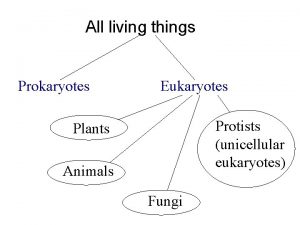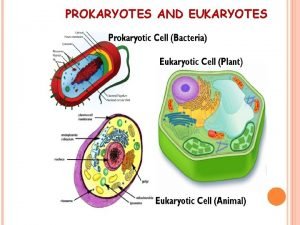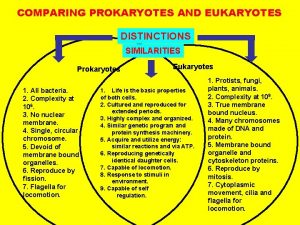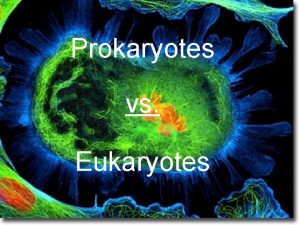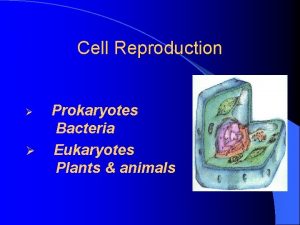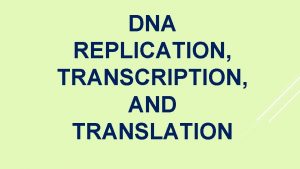Prokaryotes and Eukaryotes Differences in DNA replication and





















- Slides: 21

Prokaryotes and Eukaryotes Differences in DNA replication and chromosome structure

Differences between Prokaryotic & Eukaryotic Cells • there is usually one replication origin in prokaryotic DNA, and more than one replication origin in eukaryotic DNA

Differences between Prokaryotic & Eukaryotic Cells • in prokaryotic cells, DNA polymerase I, II, and III function in replication and repair; in eukaryotic cells, there are more than 3 different types of DNA polymerase

Difference in Chromosome Structure • the human genome consists of 23 pairs of chromosomes • if all of the DNA was stretched out, it would measure 1. 8 metres in length • how does it fit into a typical human cell nucleus, 10 micrometres in diameter?

Hierarchical Organization • DNA is coiled around a group of 8 stabilizing proteins called histones, forming nucleosomes

Chromosome Structure • solenoid = a group of 6 nucleosomes coiled into chromatin fibres • chromatin fibres fold into final chromatin structure through supercoiling.

Chromosome Structure See animation: http: //www. biostudio. com/c_%20 education%20 mac. htm

Prokaryotic DNA • primary DNA is single circular chromosome • supercoiling also in prokaryotes • plasmids are other circular pieces of DNA contained in prokaryotes • plasmids can be exchanged through conjugation

Chromosome ends • Prokaryotes have circular DNA so when DNA replicates, it always completes the circle • Eukaryotes have linear chromosomes and the ends of the chromosome present a problem to DNA polymerase

The last Okazaki fragment • Since no DNA is next to the last primer that is removed, DNA polymerase can’t finish the last strand of DNA

• As a result, the chromosomes gets a little bit shorter after every replication • DNA has built in non-coding repeating sequences to combat this – called telomeres • Telomeres also keep chromosomes linear

• after many replications, telomeres will eventually disappear, allowing coding DNA to be damaged • cell senescence = cell aging signals cell death • Hayflick limit = total number of times a normal cell can divide (about 50 in humans)

Telomeres and Aging • Once cells reach the Hayflick limit, cell functioning declines -> senescence • As an organism ages, more of its cells have reached this limit

Telomerase • Enzyme that adds new telomere sequences maintaining their length and avoiding cell aging

Dolly the Sheep First mammal cloned Born in 1996 from a donor cell that was 6 years old Shortened telomeres would be reflected in its chromosomes Expected lifespan would have been 11 -12 years but died at the age of 6.

Telomerase and Anti-aging? ? • No proof that telomere length will affect the lifespan of organism • Even with Dolly • But hasn’t stopped industry from trying to exploit the use of telomerase

“Stop Aging Now TS-X Telomere Supplement”



Telomerase and Cancer • Cancer cells have been found to have lots of telomerase allowing them to continuously divide without the loss of the telomeres • Target for cancer treatment is targeting telomerase production or activity in cancer cells more research needs to be done

Classwork • Page 294: 1, 3, 4, 5, 8, 9 • Page 298: 1 -7
 Bioflix activity dna replication nucleotide pairing
Bioflix activity dna replication nucleotide pairing Dna polymerase proofreading
Dna polymerase proofreading Where is the site of dna replication in eukaryotes
Where is the site of dna replication in eukaryotes Diff between prokaryotes and eukaryotes
Diff between prokaryotes and eukaryotes Prokaryotes and eukaryotes
Prokaryotes and eukaryotes Cytoskeletal protein
Cytoskeletal protein Multiple choice questions on prokaryotes and eukaryotes
Multiple choice questions on prokaryotes and eukaryotes Gene prediction in prokaryotes and eukaryotes
Gene prediction in prokaryotes and eukaryotes Lac operon inducible or repressible
Lac operon inducible or repressible Prokaryotes and eukaryotes
Prokaryotes and eukaryotes Are red blood cells prokaryotic or eukaryotic
Are red blood cells prokaryotic or eukaryotic Anatomy of prokaryotes and eukaryotes
Anatomy of prokaryotes and eukaryotes Prokaryotic vs eukaryotic transcription
Prokaryotic vs eukaryotic transcription Prokaryotes vs eukaryotes gene regulation
Prokaryotes vs eukaryotes gene regulation Small vacuoles
Small vacuoles Prokaryote vs eukaryote worksheet
Prokaryote vs eukaryote worksheet Prokaryotes vs eukaryotes
Prokaryotes vs eukaryotes Prokaryotes vs eukaryotes chart
Prokaryotes vs eukaryotes chart Prokaryotic cells vs eukaryotic cells venn diagram
Prokaryotic cells vs eukaryotic cells venn diagram Replication fork
Replication fork Chapter 11 dna and genes
Chapter 11 dna and genes How many dna polymerase in eukaryotes
How many dna polymerase in eukaryotes

